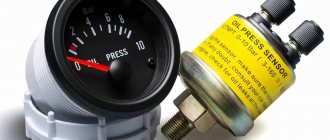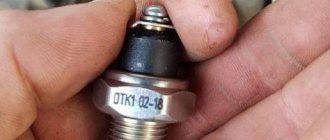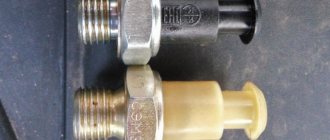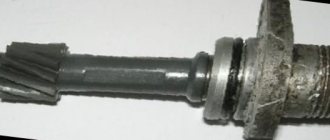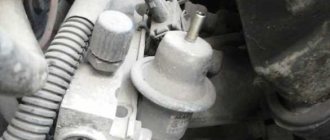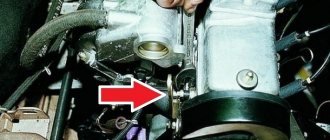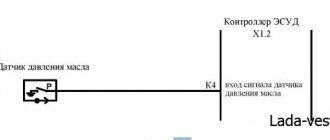If suddenly the oil pressure indicator light on the dashboard of your car lights up, one of the reasons for this phenomenon may be not only low oil pressure, but the failure of the sensor that records the internal pressure of this engine lubrication element. You will learn how to properly replace it, as well as diagnose its malfunction, below in our article. Fortunately, it won’t take much time to replace this device.
We have already written in more detail about what oil pressure should be in the engine of a VAZ-2112.
The video describes the process of replacing the oil pressure sensor on the VAZ 2110-2112 family:
Oil pressure sensor VAZ 2112
The oil pressure sensor is a fairly important part in any car, thanks to which it is possible to monitor the oil level in the engine and the pressure created by it, as well as take all necessary measures if the system for some reason begins to fail.
In the case of a VAZ-2112 car, you can find the oil pressure sensor on the left side of the engine with 16 valves. The element is located on the end surface of the housings near the camshaft bearings. This part serves to transmit information to the driver about the condition of the oil in the engine, namely its pressure in the system.
Below is a table that lists the common DDM installed on the VAZ-2112, as well as the article numbers and prices for them.
| Sensor | vendor code | Cost, in rubles |
| Oil pressure sensor Lada 2112 | 0124325089 | 200 |
| Oil pressure sensor (BCG) | OS3530-BCG | 150 |
| Oil pressure sensor (FKQ) Vernet | OS3518 | 150 |
Where is he located?
A completely natural question for those who plan to replace it themselves, but are doing it for the first time.
Sensor installation location
And its location depends on the number of valves on the engine.
- 8 valves. On an eight-valve engine, the oil pressure sensor is located directly under the valve cover on the right, near the timing belt housing, made of plastic.
- 16 valves. If it is a VAZ 2110 with 16 valves, its oil pressure sensor is located on the left between the ignition module, the oil filler neck and the air filter.
Check and replacement
During operation of the VAZ-2112, various malfunctions may occur. For example, the oil pressure sensor may fail. However, before drawing conclusions about the causes or presence of a possible breakdown, you should first check the functionality of the device.
The check is performed as follows:
- First of all, check the circuit connecting the DDM and the control lamp. To do this, take the sensor wire and lean it against the surface of the engine. At the same time as this action, you should see if the light on the dashboard is on. If the lamp goes out, then the wiring is fine and the problem is really in the sensor.
- The next step is to remove the device from the vehicle for a visual inspection. The first sign of a breakdown is the presence of moisture on the sensor.
If the DDM turns out to be dry and everything is in order with the wiring, it is recommended to look for the problem elsewhere. For example, the malfunction may be in the oil level or its quality. You can also replace the oil filter if necessary.
There is another way to check the functionality of the sensor in the VAZ-2112. It is considered more reliable and proven. In this case, you will need to use a pressure gauge, and the sequence of actions will look like this:
- First of all, it is necessary to warm up the engine until it reaches operating temperature, and then turn it off.
- Next, you need to unscrew the sensor from the car and screw in the pressure gauge in its place.
- The ground wire of the pressure gauge will need to be connected to the ground of the vehicle.
- After this, you need to connect the control LED to the battery.
- The next action is to turn on the engine and press the gas pedal. In this case, it is necessary to take into account that the speed rises gradually.
When the action is completed, you should carefully monitor the pressure gauge and LED. If the device readings reach 1.2 and 1.6 bar, but the LED does not go out, then the sensor is faulty and needs to be replaced.
To carry out the replacement you will need:
- Stock up on the necessary tools, as well as a new sensor.
- Disconnect the wires from the old device.
- Unscrew the sensor using a wrench.
- Remove the unit. In this case, during the dismantling process, you should pay attention to the fact that the sealing ring should come out along with the sensor. It will also need to be replaced.
- Install a new sensor.
- Check the contacts and clean them if necessary, then connect the wires.
When all the steps are completed, you can start the engine again and check the serviceability of the sensor.
It is worth noting that during replacement a little oil may leak out of it. In this case, you should pay attention to what kind of sensor was installed before and conclude that it may have been defective.
What to do if the sensor lights up
While the VAZ-2112 is operating, the oil pressure light on the dashboard may light up periodically.
The main causes of the malfunction are:
- decrease in engine oil level;
- electrical circuit break;
- sensor failure;
- failure of the oil filter;
- clogging of the oil receiver structure.
Since there are many possible reasons, you will need to check each of them. First of all, the car owner should inspect the engine oil level, since this reason is considered one of the most common.
To do this, you will need to turn off the engine and give it time to cool, after which you will need to inspect the pan for the amount of oil that has leaked out. If the level is OK, then you should start checking for another reason, and it is best to entrust the work to professionals at a service station.
Thus, the operation of a car, especially a domestic one, requires a responsible and attentive attitude on the part of the owner.
If you regularly inspect all elements, systems or various devices, which include the oil pressure sensor, you can avoid any serious breakdowns and, as a result, costly repair work.
Lada 2112 R12 › Logbook › Oil pressure sensor from 2106 to 2112
I came across an article on the Internet that they write that the oil pressure sensor (pressure signal) from a VAZ 2101-2106 easily fits into 2110-2112... In the fall of 2011 I encountered such a problem, it turns out how easy it is to screw it up =) I decided to try installing one from a VAZ 2106, actually and photo report)
No. 1 Fitting or adapter from the VAZ 2106 (in the VAZ 2106, 1 edge goes to the oil pressure, and the 2nd edge goes to the oil light bulb) No. 2 The oil pressure sensor itself, which gives a signal and screws into the engine (sold complete with adapter No. 2)
We unscrew this marked sensor from the VAZ 2110 engine (the oil light is something like this)
We screw the unscrewed sensor from the engine into adapter No. 2 (from the oil pressure sensor) and insert it (there is no thread there, just insert it and that’s it, the kit includes 2 washers, don’t forget to put them) into the fitting (adapter No. 1 of the oil pressure sensor)
We screw the oil pressure sensor itself into the fitting (which gives a signal) and screw this whole thing back into the engine (where the oil light sensor was unscrewed from) and hook up the wire from the oil sensor (which gives a signal) and pull it to the oil pressure sensor (arrow)
Let's go start the car and admire it) it shows 2 points when cold - which is good)
Issue price: 580 ₽
see also
Comments 93
Hello, what brand are the devices from?
Damn, everything ingenious is simple) That's what I was missing!) Thank you!
yes no) keep in mind that the MM393A pressure sensor will not work with every device. It seems to differ in the number of wires
I very much doubt that THIS sensor (MM393A) gives correct readings with THIS pointer device. The sensor has a sequential rheostat connection into the circuit of a pointer device, which, in essence, is a current meter in the circuit. Those. designed for a specific device with its own shunt. Those. more or less accurate readings will be ONLY with a dial instrument from the classics (2103, 2106) with a scale from 0 to 8 atm and 4 atm IN THE MIDDLE of the scale. With all other non-compatible pointer instruments, the MM393A sensor will show the weather on Mars.
This means I picked a suitable pointer device with similar parameters by chance)
Surprisingly, the VAZ sensor gives readings that seem to be understandable for the sensor... a honeydew sensor costs 200-300 rubles, while for Chinese barrels they ask for 2k +
yes) but the VAZ sensor is not suitable for all sensors (((
in this case, very lucky, there will be no problems with the replacement
yes) but the VAZ sensor is not suitable for all sensors (((
hi. It turns out you need to buy a sensor and take a guess? They just sell sensors without a sensor, so I want to buy one.
As far as I remember, there are sensors with 1 wire and 2 wires (maybe I’m already confused, I don’t remember it was 4 years ago))). Here is the VAZ one with 1 wire
hi. It turns out you need to buy a sensor and take a guess? They just sell sensors without a sensor, so I want to buy one.
no, listen, I lied) I don’t remember how they differ, but there seem to be 2 types. Sorry, I can’t tell you more precisely, after 4 years it’s hard to remember something (
Surprisingly, the VAZ sensor gives readings that seem to be understandable for the sensor... a honeydew sensor costs 200-300 rubles, while for Chinese barrels they ask for 2k +
What comes with Chinese DM sensors is complete garbage, the primary sensors quickly fail and generally most often show anything but real oil pressure. With the six, the primary sensor is very reliable and it won’t be difficult to find it, but all imported sensors go up to 10 bar when with the six it goes to 8 bar. The device itself is a simple voltmeter with an oil pressure scale, and the primary sensor is also a simple variable resistor which at low pressure gives high resistance and less voltage goes into the device. In theory, the error should be 0.25 bar for every real bar in the engine. That is, 1 bar in the engine = 1.25 on the sensor, 2 bar in the engine 2.5 bar on the sensor, etc.
What value should it be?
To begin with, it is worth noting that pressure is measured in bars (BAR), because we are measuring liquid. It’s unlikely that anyone will tell you the exact values now, because the structures of the engines are different, but there is a certain normal interval.
AT idle speed it is 2 BAR (or 0.2 MPa), for most cars
At 4000 - 5000 rpm - this is 4.5 - 6.5 BAR (0.45 - 0.65 MPa), also for most brands
If we take our VAZ 2112 16 valve version, then the pressure at idle is slightly higher, about 1.5 - 2.5 BAR. But at 4000 - 5000 rpm 0.4 - 0.6 BAR.
Actually, I’ll end here, I think the information was useful, read our AUTOBLOG.
(
7 votes, average: 2.86 out of 5)
Similar news
Why do you close the radiator in winter? Let's say with cardboard, the necessary knowledge
Mileage 100,000-150,000 km. Is it a lot or a little, what needs to be changed? Ra.
OTTO cycle. ATKINSON. MILLER. What is it, what are the differences in ra.
Add a comment Cancel reply
Comments
TOP articles for the month
The holidays are coming, which means most of our country will be drinking alcohol. Easy: -…
The vehicle battery voltage, as well as its capacity, are the most important indicators of this automotive unit,...
I am often asked about car emissions. Often, newbies, and even experienced drivers, don’t like…
Where is the oil pressure sensor located on the 16-valve VAZ-2112?
If suddenly the oil pressure indicator light on the dashboard of your car lights up, one of the reasons for this phenomenon may be not only low oil pressure, but the failure of the sensor that records the internal pressure of this engine lubrication element. You will learn how to properly replace it, as well as diagnose its malfunction, below in our article. Fortunately, it won’t take much time to replace this device.
The video describes the process of replacing the oil pressure sensor on the VAZ 2110-2112 family:
What you need to know about DDM?
Before diagnosing and replacing the oil pressure sensor, you need to know where the oil pressure sensor is located. First, let's briefly talk about the purpose and installation location of the device.
Purpose and location
The VAZ 2110 oil pressure sensor is a device used to notify the car owner about the low level of consumable pressure in the engine. Thanks to this controller, the owner of the “ten” can promptly determine the cause of the malfunction, as well as avoid possible problems that may occur as a result of “dry” operation of the power unit. But it should be borne in mind that if the oil light on the dashboard suddenly lights up on a VAZ 2110, there is a possibility that the problem lies in the regulator itself.
To check the device, you must first find it - the device can be located in two places, depending on the design features of the motor:
- On an 8-valve engine, the device is located on the rear of the power unit, on the right in the cylinder head connector, not far from the belt guard. One wire is connected to the DDM.
- As for engines with 16 valves, in this case the DDM should also be looked for on the rear of the internal combustion engine, only on the left, directly on the camshaft block. One wire is also connected to this controller, however, next to it there are two more bundles with wiring (the author of the video is the Auto_Remont channel).
Diagnostic features
If you notice that the emergency engine fluid pressure indicator on the dashboard is constantly on, then you should diagnose the regulator. It would be a good idea to check the wiring as well. Diagnostics of the device begins with checking the electrical circuit in the area directly from the DDM to the indicator on the device.
Purpose of the sensor
The oil pressure sensor is designed to promptly and accurately inform the driver about low lubricant pressure inside the internal combustion engine. So, as soon as the rapid detection of such a malfunction will allow you to avoid unnecessary problems and even greater engine breakdowns in the shortest possible time. It's no secret that dry engine operation can cause very serious damage to the engine. But on the other hand, you shouldn’t immediately panic and draw conclusions; it’s enough to first check the sensor itself.
Mistakes in hasty conclusions
When the oil pressure light comes on, many car owners sound the alarm and begin to fix this problem in all but not the most important ways, and these include:
- Oil change and fuel filter replacement.
- It is washed.
- The pressure is measured.
But after this, the result does not happen! Therefore, always check the oil pressure sensor first, as this is the most common and common cause.
Sensor check
It is necessary to check the functionality of the sensor in the following order:
- We remove the wire from the sensor and lean it against ground, possibly on the motor housing.
- Check to see if the light on the instrument panel lights up again.
- If the lamp stops burning, then the wiring is working properly and you can move on to the next stage of dismantling the faulty sensor.
- And if it continues to burn, then it is necessary to “ring” the wires at the entire stage from the sensor to the instrument panel to detect a breakdown or short circuit in the circuit.
Why do you need oil at all?
I often hear that oil is the lifeblood of the engine. This is not entirely true, of course, the comparison is very rough, but still, the engine will not function without oil (or it will, but not for a very long time).
Modern motor oils lubricate and protect all rubbing parts, and these are pistons (with their rings), shafts, bearings, etc. Let's just say that good oil extends the life of the engine by many thousands of kilometers.
BUT oil must flow through the system, just like blood itself through human vessels, if the oil is simply poured in a pan and does not go to the rubbing parts - IT IS USELESS!
Replacing the oil pressure sensor
To work, we only need a “21” wrench.
We make the replacement as follows:
- When the sensor is detected, we clean its surface and around it from dirt and deposits so that some of the dirt does not get into the engine.
- Then disconnect the power supply from it.
When dismantling, we inspect it for defects and damage.
It's easy enough to rip off the nut and then just unscrew it by hand.
Pay attention to the quality of the connection.
In this simple way, the work on replacing the sensor can be considered completed.
